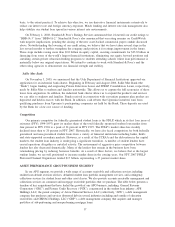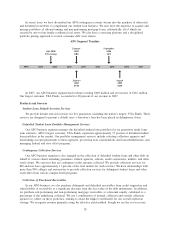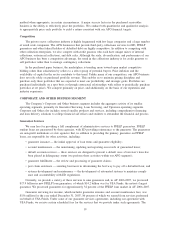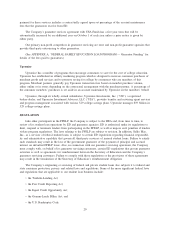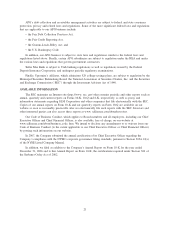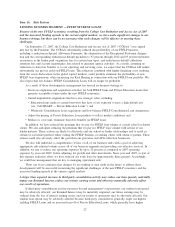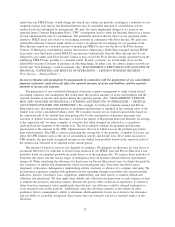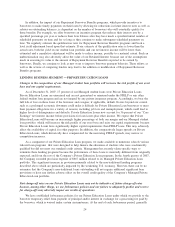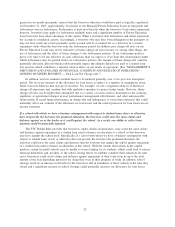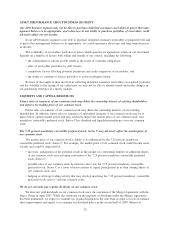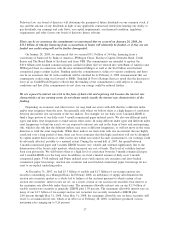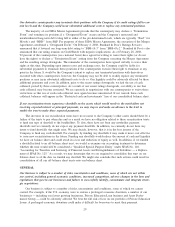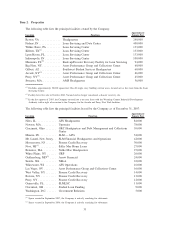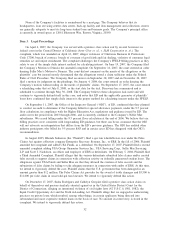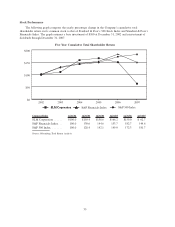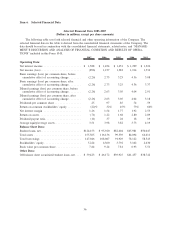Sallie Mae 2007 Annual Report Download - page 28
Download and view the complete annual report
Please find page 28 of the 2007 Sallie Mae annual report below. You can navigate through the pages in the report by either clicking on the pages listed below, or by using the keyword search tool below to find specific information within the annual report.Delaware law, our board of directors will determine the payment of future dividends on our common stock, if
any, and the amount of any dividends in light of any applicable contractual restrictions limiting our ability to
pay dividends, our earnings and cash flows, our capital requirements, our financial condition, regulatory
requirements and other factors our board of directors deems relevant.
There can be no assurance the commitments we announced that we secured on January 28, 2008, for
$31.3 billion of 364-day financing from a consortium of banks will ultimately be funded, or if they are not
funded our credit rating will not be further downgraded.
On January 28, 2008, we announced that we secured $31.3 billion of 364-day financing from a
consortium of banks led by Bank of America, JPMorgan Chase, Barclays Capital, Deutsche Bank, Credit
Suisse and The Royal Bank of Scotland, and from UBS. The commitments are intended to replace the
$30.0 billion asset-backed commercial paper conduit facilities that we entered into with Bank of America and
JPMorgan Chase in connection with the now terminated Merger as well as the $6.0 billion asset-backed
commercial paper conduit facility. Funding under the commitments is subject to various conditions and there
can be no assurance that all such conditions will be satisfied. In its February 4, 2008 announcement that our
counterparty credit rating was lowered to BBB-, Standard & Poor’s Ratings Services noted that the decision to
leave us on CreditWatch Negative reflects that the funding of the commitments is still subject to various
conditions and that if the commitments do not close our ratings could be reduced further.
We are exposed to interest rate risk in the form of basis risk and repricing risk because the interest rate
characteristics of our earning assets do not always match exactly the interest rate characteristics of the
funding.
Depending on economic and other factors, we may fund our assets with debt that has a different index
and/or reset frequency than the asset, but generally only where we believe there is a high degree of correlation
between the interest rate movement of the two indices. For example, we use daily reset 3-month LIBOR to
fund a large portion of our daily reset 3-month commercial paper indexed assets. We also use different index
types and index reset frequencies to fund various other assets. In using different index types and different index
reset frequencies to fund our assets, we are exposed to interest rate risk in the form of basis risk and repricing
risk, which is the risk that the different indices may reset at different frequencies, or will not move in the same
direction or with the same magnitude. While these indices are short-term with rate movements that are highly
correlated over a long period of time, there can be no assurance that this high correlation will not be disrupted
by capital market dislocations or other factors not within our control. In such circumstances, our earnings could
be adversely affected, possibly to a material extent. During the second half of 2007, the spread between
3-month commercial paper and 3-month LIBOR became very volatile and widened significantly due to the
deterioration of the broad credit markets, which increased our cost of funds. This level of volatility had not
been seen previously. We still believe there is a high level of correlation between 3-month commercial paper
and 3-month LIBOR over the long term. In addition, we fund a limited amount of daily reset 3-month
commercial paper, T-bill indexed and Prime indexed assets with auction rate securities and asset-backed
commercial paper borrowings. Auction rate securities and asset-backed commercial paper borrowings do not
reset to an explicit underlying index.
At December 31, 2007, we had $3.3 billion of taxable and $1.7 billion of tax-exempt auction rate
securities outstanding on a Managed Basis. In February 2008, an imbalance of supply and demand in the
auction rate securities market as a whole led to failures of the auctions pursuant to which certain of our
auction rate securities’ interest rates are set. As a result, certain of our auction rate securities bear interest at
the maximum rate allowable under their terms. The maximum allowable interest rate on our $3.3 billion of
taxable auction rate securities is generally LIBOR plus 1.50 percent. The maximum allowable interest rate on
many of our $1.7 billion of tax-exempt auction rate securities was recently amended to LIBOR plus
2.00 percent through May 31, 2008. After May 31, 2008, the maximum allowable rate on these securities will
revert to a formula driven rate, which, if in effect as of February 28, 2008, would have produced various
maximum rates ranging up to 5.26 percent.
27


